A Dawdle through Milber Woods
Austerity measures have forced us to think differently of late. In 2005, when we drove up to the Scottish Highlands on holiday, petrol prices were below eighty pence per litre. Back then, paying a pound for every litre of fuel seemed like a distant prospect, the stuff of science fiction. And here we are in 2012 staring down the wrong end of what has been termed a 'double dip.' Isn't it funny how commentators tend to use trivial terms to mask serious issues?
The bottom line is we're not getting out as far and wide as we used to, or as often as we would like. And yet it is still possible to cast a net locally and discover gems of places that have been overlooked. I like to spread a map out on the floor and when the cat has tired of putting her paws all over the areas I'm interested in, I pore over the grid squares, playing at being Zeus; trying to look beyond the contours and symbols and structures; trying to imagine myself wandering through a landscape for real.
Within a thirty mile radius of home, we are still finding ample new places to explore. Sometimes, there is a tendency to ignore urban areas in favour of the open countryside. This must be one reason why we have never been to Milber Woods before. On the map, Milber is a green strip between roads and residential blocks, unassuming on the face of it and easy to ignore.
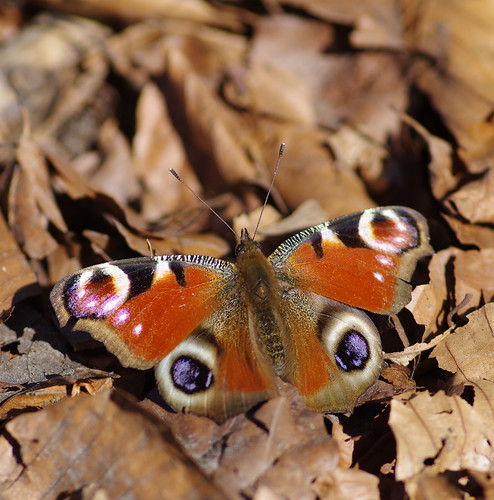
Peacock Butterfly (Inachis Io)
We were literally just past the boarded sign at the entrance when we encountered this butterfly basking down among the dried leaves. The main avenue was open and airy, a mixture of conifers, beeches and sweet chestnut trees. There were also grey squirrels in abundance, cheekily darting hither and thither, up between the treetops and down on the ground.
Squirrels must be the Lady's favourite animal. I think our collie harbours an ambition to turn into a squirrel one day. She watches their death-defying leaps and now and again gives an excited yelp of pleasure. I think it all stems from a walk along a country lane about four or five years ago. To our astonishment, a squirrel leapt from a tree some twenty feet or so above our heads, landed on all fours in the road right in front of us and then bounded away down the lane completely unharmed. I've never seen anything like it before or since. It's not the sort of thing you forget in a hurry, whether human or canine. Whenever Lady sees a squirrel in a tree, she runs around in a frenzy, looking upward, wishing she could emulate their acrobatic feats.
Milber's squirrels are obviously used to humans and their pets because they seem to show no inhibitions in their performance. We continued through the wood and then as the paths inevitably diverged, we kept left, parallel to the main road. At the far end of the reserve, a notice detailed how thousands of daffodils have been planted to be a good nectar source for bumblebees. We will have to come back earlier next year to capture the flowers in all their glory.
At the end of the wood, we go straight on along Milber Lane, passing a fenced-off quarry. From up here the scale is impressive. I can remember in years gone by passing the modest site entrance on the road. One day when the sand has been exhausted, the site may be returned to nature as many others have around the country. In the hills beyond, the gigantic, gouged-out crater, zig-zag terraces run diagonally across the hillside. From my days in Geography lessons, I can dimly recall that these terraces were created by glacial deposits but the exact details escape me. Now they are like steps for the wandering sheep to negotiate.
From the end of the lane, we take a left up the hill to examine the hedgerows. There are wild strawberries with their blushed pink flowers that will turn to fruit in a matter of weeks. Hart's-tongue ferns are arranged in side profile, unfurled at different angles as if the sunlight is coaxing them out like cobras from a basket, and Shining Cranesbills with their small but bright display and red-edged leaves. Everything is growing up and the hedgerows are alive with plants competing with each other.

A Spleenwort Fern (either Black or Lanceolate)
Learning about ferns is proving a challenge. I cannot decide whether the specimen above is in the process of unfurling or in its final stages of transformation. There are no spores on the underside. When they start to appear, later in the year I will hopefully be able to identify several different species and add them to our nascent database.

Bush Vetch (Vicia sepium)
Vetches proliferate in tangles among the hedgerows in spring. Different species vary in colour from purple to pink and how they are arranged. The opposite pairs of leaves are hairy and have a pointed spine at their tip. The seed pods will develop later. But it is the tendrils at the end that always amuse me, reaching out in elegant, elaborate curves.
At the top end of the lane, the dense cover evaporates and we find ourselves unaccustomed at first to the harsh light. Spanish bluebells here have a sickly, shiny sheen as if they have been eggwashed. Red Campions stand tall and we cross over the main road and head along the aptly-named Long Lane. A boy driving a tractor passes us. We turn to watch the dusty trail in the distance.
We are turning for home now but first we have an overdue and very important appointment: lunch. As always, it's a case of finding the right place to stop. In the end, we decide to wait until we are back in Milber Wood. A picnic bench covered with bird seed serves our purpose. Linda and Mick, our companions for the day, make themselves comfortable and get the portable stove going.

The Boy Who Never Grew Up
After lunch, Mick is eager to prove his tree-climbing abilities. He springs up acrobatically and we watch in awe as he falls in slow-motion like a well-rehearsed stuntman. Except that this is no stunt. Thankfully Mick lived to tell the tale but next time he sees a cherry trunk he might think twice before clambering up it.
On our way back through the wood we inspected a number of trunks; peeking into a minature world of wonders.
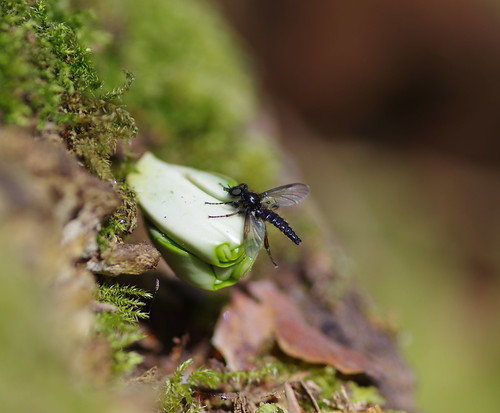
St Mark's Fly (Bibio marci)
Sherry spotted this species. I think it is St Mark's Fly, so-called because traditionally they are said to emerge on St Mark's Day . These flies are fairly common here. The specimen above is probably the female, considerably smaller than the male.
When we left Milber Wood behind we decided to walk back through a leafy suburb. It's sometimes easy to forget about roadside verges. The council employees with their weedkillers have not been through these parts recently so we were able to see a number of flowers classed as weeds including the edible Common Cornsalad, daisies and speedwells.
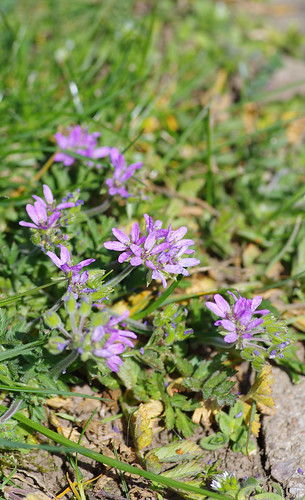
Musk Stork's-bill (Erodium moschatuml)
I see these flowers regularly among lawns and unkempt verges. But what really rounded off our walk was the breadth of blossom above our heads in the trees.
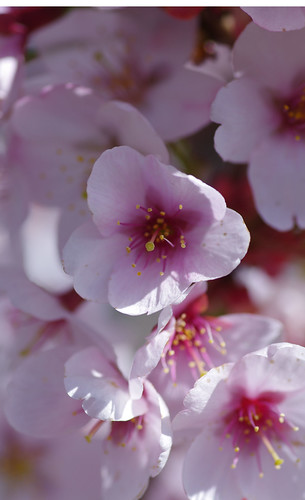
Cherry Blossom
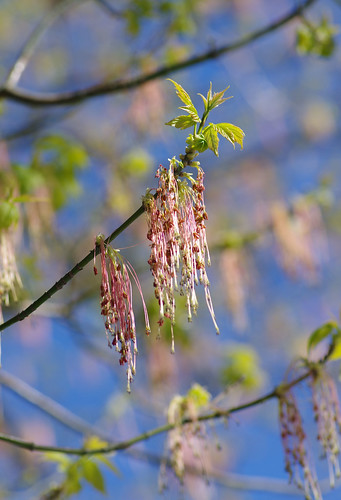
I have still not managed to identify these overhanging flowers. The tree was on the grassy verge between pavement and road. I thoroughly enjoyed our excursion and it just goes to prove that you can never get to really know a place just by passing through it.
We would like to thank Linda and Mick for another memorable day out.

Comments
Add a Comment